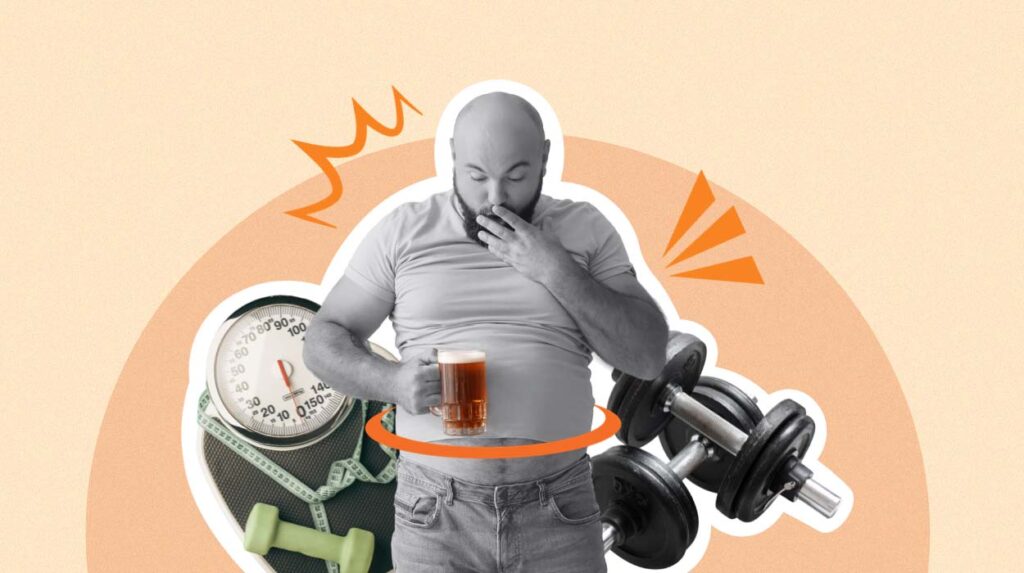
Everyone’s weight loss journey is unique and may depend on the individual’s body type, genetics, and medical conditions. Some people tend to show more weight around their torso, while others gain weight around their thighs. But every person who starts a weight loss regime has the same intention and goal – to shed off stubborn fat. And, after weeks or months of shedding blood, sweat, and tears, you’re bound to see results in one form or another. However, the question remains how much weight do you need to lose exactly to notice a difference. This article discusses the number of pounds you need to drop before you can notice a healthier, stronger version of yourself.
How Much Weight To Lose To Notice A Difference?
As mentioned before, your body type, height, and body mass index (BMI) play a big role in shedding your body’s extra weight. Though, on average, you are required to lose nearly 14 – 18 pounds to see visible changes and differences in your weight. The best way to lose weight and keep it down is by incorporating a healthy weight loss regime that focuses on losing 1 to 2 pounds per week. Challenges and diets that offer quick fixes are not sustainable in the long run; rather, you can gain all that weight back just as quickly as you lost it.
What Research Says About Weight Loss?
Canadian researchers have studied[1] weight loss and claim that the difference in weight loss is first noticeable through the face. Associate professor Nicholas Rule and Postdoctoral fellow Daniel Re studied facial adiposity – a salient facial cue that plays an important role in our perception of health and attractiveness – because it is an accurate measurement of a person’s Body Mass Index (BMI). BMI is a person’s weight in kilograms divided by the square of the person’s height in meters.
The study consisted of a compilation of photos that features the faces of men and women within the age bracket of 20 and 40. The people in the photos were bare-faced, meaning they didn’t wear any makeup or jewelry. Additionally, their hair was pulled back and they posed with neutral facial expressions.
The photos were then duplicated to make it seem like a person was gradually gaining weight. After which, the participants were asked to compare the faces from each sequence and chose the heavier one. Through this method, the researchers were able to estimate the amount of weight loss needed before all those shredded pounds become noticeable.
Rule and Re determined that men and women of average height need to lose approximately eight or nine pounds for the weight loss to be noticeable. However, to seem more attractive based on some universal standards of beauty, men and women need to lose about 6.3 and 8.2 kilograms (which is about 14 and 18 pounds), respectively.
Any BMI calculator or chart will tell you that a ‘normal’ or healthy BMI ranges between 18.5 to 24.9. Anything below or above that is an indication that the person is underweight or obese. Hence, your goal should be to fall into this range; and once you do, make sure you sustain it.
Where Do We Lose Fat First?
Surely, our bodies need to lose the extra pounds in some areas more than others. Unfortunately, weight loss doesn’t work that way. Spot training is a long-standing myth that has been debunked[2] by several medical and health experts. When we consume more calories than we burn, our bodies store the extra fat, resulting in weight gain. This extra fat is evenly distributed around the body, and while certain exercises can help tone parts of your body, they can’t help you reduce fat in that particular area alone.
Where you lose fat first is decided by your body and can be influenced by several factors such as your diet, workout regime, hormones, and age. Many researchers have studied[3] the relationship between age and weight loss at certain body parts; the results of which have led them to believe that middle-aged man, and women who have experienced menopause tend to store fat around their midsections.
Though, there are some studies[4] that state men tend to lose more weight around their trunk area while women see rapid weight loss at their hips.
When Does Weight Loss Become Prominent?
Various factors such as diet and exercise influence our weight loss process but there’s no clear-cut answer regarding how soon your weight loss will become noticeable. Here are some tips to keep in mind while noting your weight loss progress.
Starting Size
Your starting size determines the initial weight loss. People with a lower BMI have less fat to lose and hence, their weight may come off slowly. At the same time, those who lie in the obese range and perform little to no activity will see quicker results once they start eating healthy and working out. However, this is only valid during the initial stages, and anyone who continues to put in the hard work will see results soon. A healthy diet and a 500 calorie deficit[5] per day can help you shred 1 or 2 pounds per week.
Type of Diet
While researching weight loss, you must have come across the 80-20 ratio, which states that 80% of your weight loss goal is achieved through a healthy diet while the remaining 20% is met by exercise.
Some diets like Atkins and South Beach promote accelerated weight loss by placing an intense restriction on food for a week or two. By adopting this diet, you can expect to lose up to five pounds during this period. Though it should be noted that the pounds lost here are water weight and not fat loss, meaning you can just as quickly gain it all back if you revert to old eating habits.
Measurement Method
The way you measure your progress can save you a lot of stress and time. When you think of weight loss, the first thing that comes to mind is a lower number on the scale. However, this isn’t an accurate measurement of your weight loss progress. Instead, you should opt for a holistic approach such as reduced clothing size or a body fat scale.
If you wear fitted clothing, losing a couple of inches will be more noticeable in the form of looser clothes. This technique allows you to understand which part of your body has lost fat – something that isn’t possible with a regular scale.
Another method to consider is a body fat scale. A body fat scale uses bioelectrical impedance to determine your body’s fat to mass ratio. Since strength training can mean an increase in weight, this approach will provide you with an accurate fat loss number.
Progress Pictures
As mentioned before, your main goal should be to lose fat and not numbers on the scale. Hence, snapping before and after pictures will show you results in terms of inches and fat loss. Clicking pictures every few weeks in similar angles to note the fat around your arms, belly, hips, and thighs will help you view your progress first-hand.
Change in Clothing Size
Fitting into the smallest size possible is considered a weight-loss achievement for most people. If you’re someone who’s looking to fit into small-size clothing, this tip will help you understand how much weight you need to lose before you can wear your ideal size.
Height is an interesting factor that comes into play here. The taller the person, the more they are at a disadvantage of fitting into smaller clothes even after weeks of intense training. For example, a petite, 5 ft woman can expect to lose nearly 10% of her body weight with each 10-pound weight loss. But a tall, athletic woman may not observe any change with the same amount of weight loss.
This is simply because, with a shorter frame, the body has fewer areas to target resulting in a more noticeable outcome. Still, losing 10 – 12 pounds is a big enough difference, and most people happily fit into a smaller size or two after shedding this amount of body weight.
However, since our bodies don’t lose weight evenly, it’s good to know the specific number of pounds to drop around each body part.
- Change in pant size: To fit into a smaller pant size, you need to lose about 1 to 1.5 inches around your waist and hip.
- Change in top size: If you fit into medium and large sizes, you need to lose 1.5 inches around your bust and waist. For those who fit in small-size clothing (8 and below), a mere loss of one inch in the bust and waist will help you drop your clothing size further.
- Change in dress size: Depending on your preference of dress styles, you need to reduce your bust, waist, and hip by one inch each.
Improved Health and Stamina
New clothing size and a smaller physique is not the only way to measure your weight loss progress. Research[6] states that incorporating a healthy diet and increasing physical activity improves your body’s overall health. By losing visceral fat – unhealthy fat that wraps around your abdominal organs – and increasing your body’s stamina and endurance, weight loss and a healthy diet prove to be beneficial in the long run.
As you make changes to your lifestyle, you will notice an improved mood, lowered anxiety and stress, and an increase in stamina. These are noteworthy signs that your weight loss regime is working.
A Few More Tips to Keep Weight Loss Noticeable
Losing fat and maintaining your ideal weight requires you to make certain lifestyle changes. Here are a few things that will help you notice a change in weight difference in no time.
- A healthy amount of carbohydrate intake
- Portion control diet
- Drink plenty of water throughout the day
- Intermittent fasting
- Cut on sugars, salt, and junk food completely.
- Eat a healthy amount of soluble fibers
- Exercise along with diet
- Consume healthy fats
In a Nutshell
Following intense diets and exercises are not suitable in the long run. This is because it is not doable for long periods and most people quickly fall into old habits, ruining all the progress they achieved. Therefore, it is recommended to make gradual changes to your lifestyle so that you not only notice a weight change but are able to maintain it long term too.
+ 6 Sources
Tnhealth has strict sourcing guidelines and relies on peer-reviewed studies, academic research institutions, and medical associations. We work mostly with peer-reviewed studies to ensure accurate information. We avoid using tertiary references. You can learn more about how we ensure our content is accurate and current by reading our editorial policy.
- University of Toronto News. (2015). Losing weight can make you more attractive, experts say – but there’s a catch. [online] Available at: https://www.utoronto.ca/news/losing-weight-can-make-you-more-attractive-experts-say-%E2%80%93-theres-catch [Accessed 21 Oct. 2021].
- Dublinohiousa.gov. (2020). Get Away from Spot Reducing – It Doesn’t Work that Way | Thrive in Dublin, Ohio, USA. [online] Available at: https://www.econdev.dublinohiousa.gov/get-away-from-spot-reducing-it-doesnt-work-that-way/ [Accessed 21 Oct. 2021].
- Soares Costa de Mendonça, R.M., Targino de Araújo Júnior, A., Cirilo de Sousa, M. do S. and Fernandes, H.M. (2014). The Effects of Different Exercise Programmes on Female Body Composition. Journal of Human Kinetics, [online] 43(1), pp.67–78. Available at: https://www.ncbi.nlm.nih.gov/pmc/articles/PMC4332186/ [Accessed 21 Oct. 2021].
- Benito, P.J., Cupeiro, R., Peinado, A.B., Rojo, M.A. and Maffulli, N. (2017). Influence of previous body mass index and sex on regional fat changes in a weight loss intervention. The Physician and Sportsmedicine, [online] 45(4), pp.450–457. Available at: https://pubmed.ncbi.nlm.nih.gov/28914104/ [Accessed 21 Oct. 2021].
- Medlineplus.gov. (2015). 10 ways to cut 500 calories a day: MedlinePlus Medical Encyclopedia. [online] Available at: https://medlineplus.gov/ency/patientinstructions/000892.htm [Accessed 21 Oct. 2021].
- CDC (2020). Physical Activity for a Healthy Weight. [online] Centers for Disease Control and Prevention. Available at: https://www.cdc.gov/healthyweight/physical_activity/index.html [Accessed 21 Oct. 2021].







 By
By 


 By
By 
 By
By